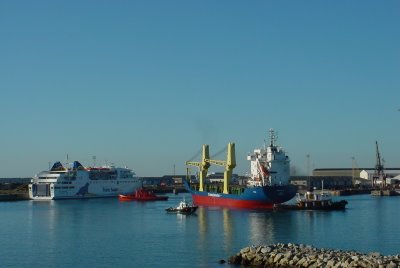This kind of ships (dead ships as we call them) requires particular shiphandling techniques since they must be moved using tugs only, and, sometimes, lines passed to a capstan ashore.
As can be imagined, these manoeuvres should only take place with very good weather, but this is not frequently the case due to tidal window restrictions.
As we have no direct control on the ship it is of the utmost importance to plan the intended manoeuvre with the tugs captains, as they will play a major role in the successful berthing, unberthing or shifting.
The most important thing is to prevent the ship from moving too fast in any direction as it will require a stronger pull on the contrary direction to stop it. Other thing to remember is that the tugs take some time to position on the other side, and while they are changing position, you can’t do anything onboard.

The container vessel "Ponta do Sol" being shifted from drydock to fitting berth with "Vandoma" astern and "Monte Xisto" fast on the bow. Seen alongside is "Lobo Marinho".
Even with smaller ships it is always important to do it very slowly because once they put on some momentum it will demand corrective action by the tugs, which can end with a broken line, jeopardizing the rest of the operation.
Having no power on the winches, we must bring the ship close enough to her berth to allow the lines to be passed to a shore capstan in order to go alongside in the required position.
We perform these manoeuvres with all kind of vessels, ranging from tankers, ferries, container ships, warships and even with ships still under construction where we have to look for an adequate place to “conduct the orchestra” since sometimes there are no bridge wings yet…
No comments:
Post a Comment